For several weeks now we’ve tracked the interesting phenomena of Russia’s tanks equipped counter-FPV shells, known by many names – Tsar’s BBQs, assault sheds, Blyatmobiles or Turtle Tanks. These vehicles began to appear in April around Krasnohorivka but since then have spread to numerous other sectors. Most recently they have played a role in the Russian offensive towards Kharkiv.
Check out our earlier articles/videos on the Turtle Tanks
They combine a number of features including the large characteristic sheet metal shells, electronic warfare systems to jam drone control frequencies to protect against first person view (FPV) suicide drones. They also often feature devices such as mine plough and rollers to enable them to act as breaching vehicles.
Since other last video there have been even more interesting variations on the ‘turtle tank’ concept and also a fair amount of imagery showing them being successfully engaged. Which raises the question: has the tide turned on the Turtle Tanks?
On the 8 May photos of a Russian T-72B3 being fitted with a counter-FPV shell were posted. OSINT account Naalsio noted that while the tank had tactical markings denoting the 68th Guards Tank Regiment, 150th Motorised Rifle Division, 8th Guards Combined Arms Army, Southern Military District, the original Telegram post said that the work was carried out by the 104th Separate Tank Battalion of the 7th Guards Airborne Assault Division. In the photos we can see the assembly of a frame projecting from the tank’s sides with slightly angled sheet metal being welded to the frame.
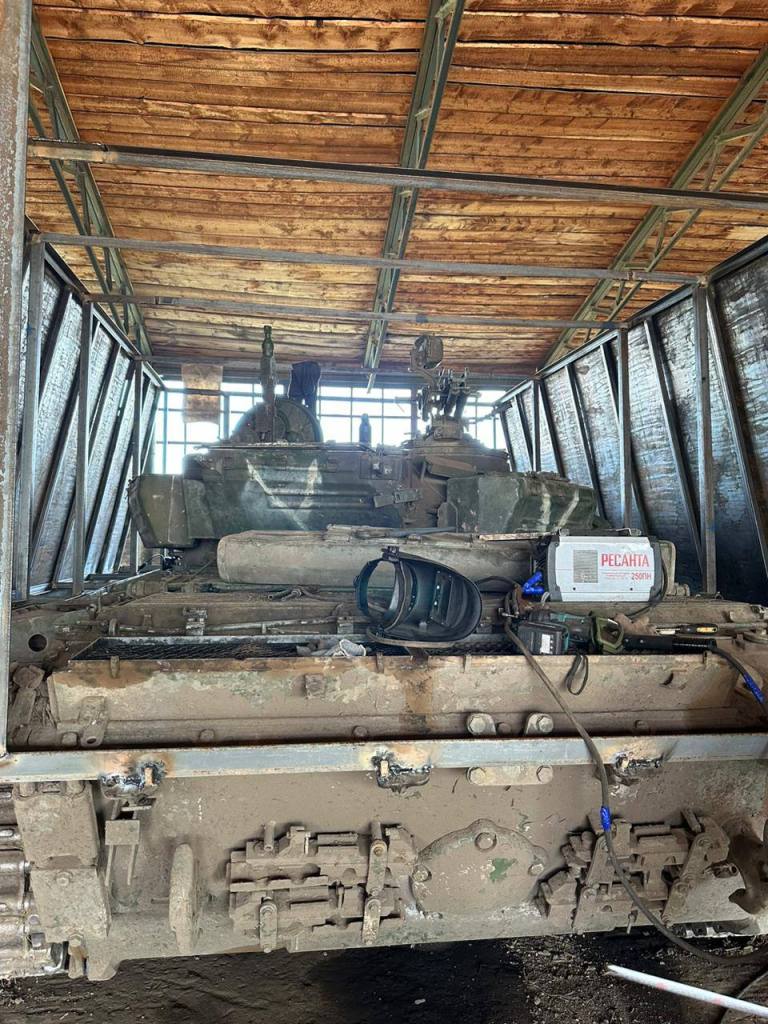
Ukraine’s Presidential Brigade shared some FPV footage of what may be another ‘Turtle Tank’ near Vuhledar. The resolution of the footage is low but the vehicle appears to have an EW module on top of its counter-FPV shell. Its unclear if the shell is solid s heet metal or if its is a mesh screen which covers the top part of the vehicle and has been shrouded in camouflage netting.
On 13 May, photographs of a pair of tanks fitted with shells were shared, with at least some of the work seemingly being completed in the field with a welder hooked up to a generator. The first vehicle has a visible framework and the sheet metal used to have surface rust. A possible second tank has a less angled shell and horizontally orientated metal sheeting. Markings visible on the first tank may suggest it tank belongs to the 3rd Motor Rifle Division’s 752nd Motor Rifle Regiment.
Also on the 13 May, the 3rd Assault Brigade claimed that the 3rd along with the 66th Mechanized, and 77th Airmobile Brigades had engaged Russian forces on the Kharkiv front and struck a ‘turtle tank’ with FPVs.
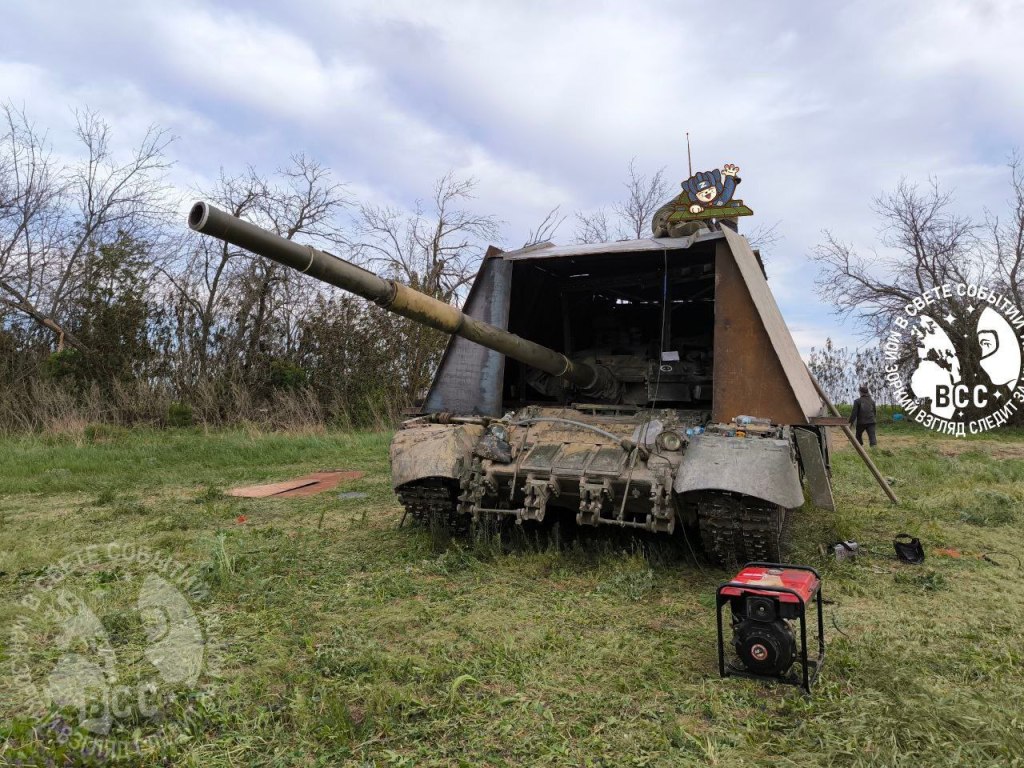
Footage of a recovered damaged ‘turtle tank’, which may be the tank which was immobilised during the initial assaults on the Kharkiv front, shows the tank’s shell badly damaged and its left-side track lost, however, its KMT-6 mine plough is still present.
The clearest imagery of of a knocked out ‘turtle tank’ which has appeared so far also emerged on 13 May. Three images taken by an observation drone show a T-62 which shares a numerous construction characteristics with the earlier ‘porcupine turtle’ seen on 5 May. It has similar protective grills made from cages which completely cover the outer metal sheets of the counter-FPV shell. However, its rear is not enclosed by sheet metal but a combination of sheets and grating.
The tank doesn’t have any visible electronic warfare equipment but is fitted with what appears to be a BTU-55 dozer blade mounting point (H/T – Ross) which is no longer present and not visible in the available imagery (although what appears to be a KMT-6 mine plough can be seen on the ground behind the tank). The tank clearly has signs of fire damage along its side and rear and the front portion of its shell as been blown inwards and warped, cause unclear though it may have been an artillery strike, ATGM hit or an FPV. Intriguingly, inside the shell appears to be an earlier pre-existing ‘cope cage’ shelter on the turret which does not not a part of the outer shell structure.

Further examples of tanks equipped with counter-FPV shells, which both sides increasingly refer to as ‘сарай’ or sheds, have been shared. Drone footage of a Russian T-72B3 equipped with a ‘shed’ was shared early on 14 May showing the vehicle on fire, with smoke billowing from its roof, and under attack by FPVs. The footage has reportedly been geo-located to Novovodyanoe, in the Luhansk region. Again the shell is made up of sheet metal with a rear hatch and an additional mesh roof screen. The tank has a broken track and one shot from the footage appears to show the vehicle surrounded by TM-62 anti-tank mines suggesting the vehicle entered a mine field. The vehicle does not appear to be fitted with a mine plough or roller.
Additionally imagery of another T-62-based ‘turtle tank’ were also shared, date and location unknown, but the now standard construction of a rough internal framework made from box metal and then sheet metal welded onto the frame. From the photos it appears it may be fitted with a mine plough. Only one side of the shell has been completed but there is also a small ladder welded onto the frame at the rear for access to the engine deck. Intriguingly, we can also see that the frame itself has been welded to the tank’s turret with two angled struts meaning that the tanks turret cannot be traversed at all.

On the 14 May, footage of another knocked out ‘turtle tank’ emerged showing a burning tank near Andriivka in Donestsk. The tank appears to have been part of an armoured assault which may have been halted by artillery fire. The tank appears to be a T-62 fitted with KMT-6 mine plough. The vehicle is on fire with a significant portion of its shell blown off on its right side. The video also shows an FPV drone striking the tank from the rear. A further video appears to show an FPV able to enter the rear of the shell. The Ukrainian Ministry of Defense attributed the destruction of the tank to ‘Javelins and FPV drones’ deployed by the 93rd Mechanised Brigade.
On the evening of 14 May, the 79th Air Assault Brigade shared video of another Russian attack in Novomykhailivka, in Donetsk. This showed several intriguing vehicles including a hybrid-turtle which had a layer of tyres under some cage armour and a camouflage net. [Additional footage here] Another brief shot showed a tank, with no visible main gun, moving across open ground. It is equipped with a KMT-7 mine roller and a counter-FPV shell/shed which is open fronted with no additional protection such as a chain curtain or wire cages. It appears the assault was met with both artillery and FPVs.
On the 15th, observation drone footage was shared of a badly damaged, burning ‘turtle tank’ which was destroyed by the Ukrainian 72nd brigade during a Russian attack in the Vuhledar sector. The date of the engagement is unconfirmed but the video shows the vehicle being destroyed in a spectacular explosion, likely due to a cook-off of ammunition.
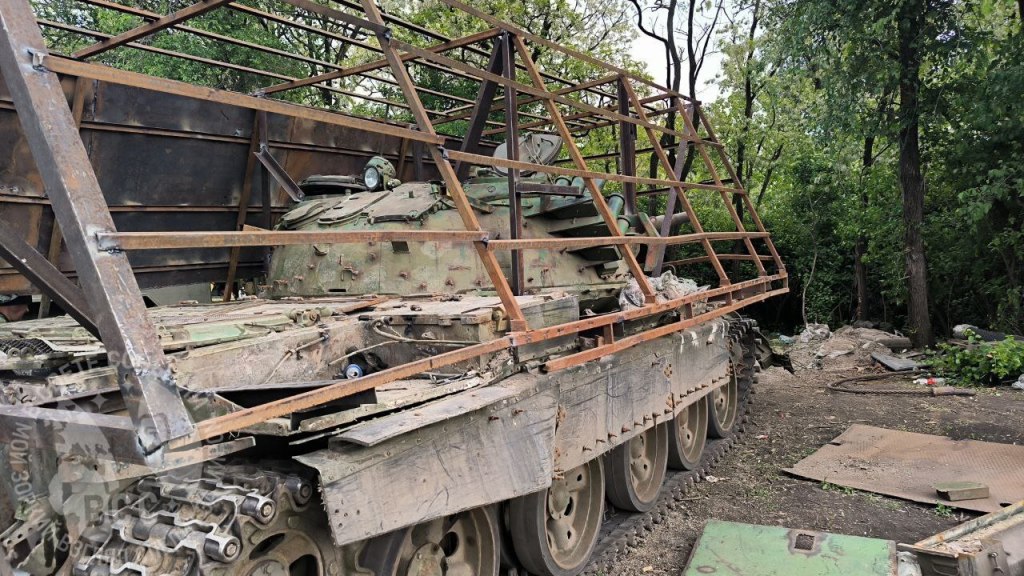
On the 15 May another image of a converted T-72 in Donetsk emerged. Visible in the photo is a sheet metal counter-FPV shelter equipped with a layer of outer wire cages. A KMT-6 mine plough is fitted and a chain curtain protects the turret while providing decent visibility for the tank’s frontal arc. Additionally a commercial surveillance camera has been attached to the roof of the shell. An АЕК-902 smoke discharger is attached to the top of the shell and ERA blocks have been attached to the skirt and then enclosed partially by a wire screen.
On the 16 May, Russian military vlogger Large Caliber Trouble shared a series of videos which featured armoured vehicles fitted with counter-FPV shells. The first video showed an armoured assault with three vehicles with shells/sheds and one tank without. The footage, from an observation drone, is too low resolution to fully make out the configuration of the Turtles but its clear that the lead vehicle is equipped with a set of mine rollers. The assault column is bracketed by Ukrainian artillery fire and the lead tank is damaged and forced to turn back. While the second moves up and deploys smoke from an AEK-902 launcher the lead tank appears to take a direct hit to its rear, possibly from an FPV drone.
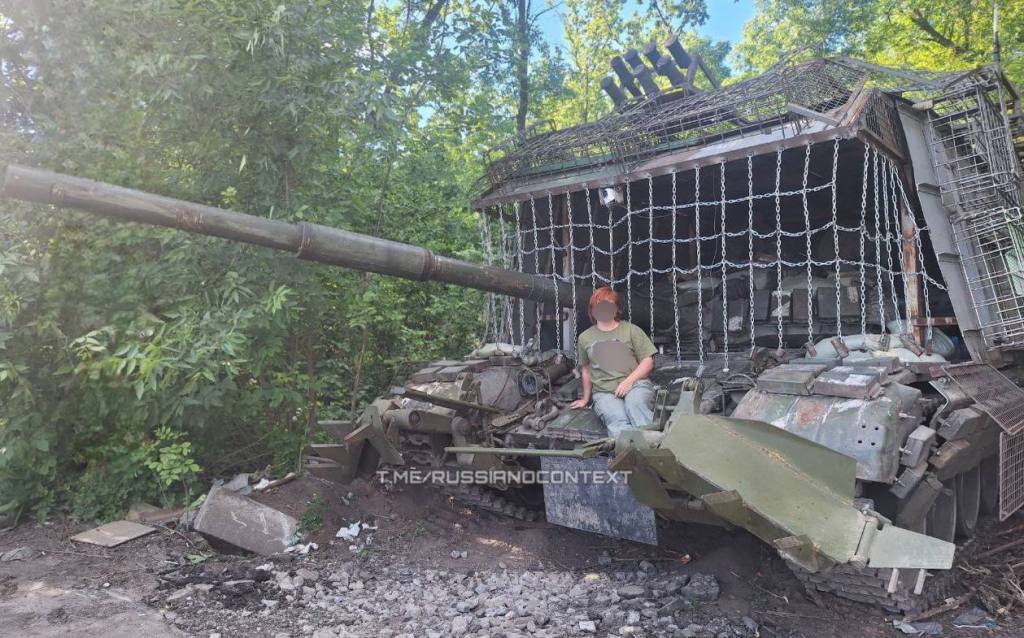
One of the tanks is called the ‘scorpion’ and is tasked with “clearing mines and identifying enemy points”. In a video showing the vehicle in action it is clear that the design is substantially different to previous ‘turtle tanks’ with no visible main gun, a fully enclosed front and an overhanding sheet metal rear awning. The vehicle is also equipped with a KMT-7 mine roller. In another post he described the vehicle as “a captured tank with a cut-off turret” that used “different building materials for [the] armor”. He claims it was “hit by 8 anti-tank guns and countless artillery shells.”
As always with these breakdowns we have to remember that we don’t have the full picture and the available imagery represents a fraction of what is happening on the frontline. As mentioned in the previous article/video the ‘turtle tanks’ are just as susceptible (if not more) to conventional means of knocking out tanks: mines, artillery and anti-tank guided missiles. It remains to be seen if a new trend is emerging that suggests that Ukraine is now increasingly capable of successfully countering the Russian assault sheds or if indeed the Turtle Tank will adapt again.
Updates
Update – 19/05/24:
On 18 May, the drone unit with the 3rd Assault Brigade shared further video of the ‘turtle tank’ that was first seen on 8 May. Filmed at the same time they stated that they came across an immobilised and abandoned ‘turtle tank’ and made several sorties to damage the vehicles engine and main gun.
Also on the 18 May, FPV camera footage from the 93rd Mechanised Brigade’s SIGNUM unit showed the ‘turtle tank’ first seen in footage shared on 14 May, near Andriivka in Donestsk. The first FPV can be seen to dive and strike the upper, right side of the shell. Another comes in low targetting the tank’s wheels while a third attacks the open hatch at the rear.
On the 19 May, several photos of hybrid-Turtles were shared by the Russian Ugolok_Sitha telegram channel showing T-62Ms with either a mine roller or a plough as well as camouflaged cope cages or Turtle-style counter-FPV shells made from gratings rather than solid sheet metal which have then been camouflaged with netting.
It emerged on 19 May that the ‘Scorpion’ showcased by Large Caliber Trouble three days earlier had apparently been successfully engaged. CyberBoroshno shared a short clip showing the vehicle being struck by FPV drones and set alight. CyberBoroshno suggested the vehicle was an ‘atypical MT-LB’ but it is likely the tank, which had had its gun removed, was a T-62M.

On the evening of the 19 May, the 81st Airmobile Brigade shared drone footage of a pair of MT-LBs, both equipped with counter-FPV shells and both destroyed. The first MT-LB appears to have had its corrugated metal shell panels blown off and is burnt out. The second vehicle’s shell design is different with sheet metal panels and a cage frontage. The footage is said to have been filmed near the village. Belogorivka, Lugansk
Update – 20/05/24:
On 20 May, a Ukrainian telegram channel shared a video of another ‘Turtule Tank’, again with no visible main gun but with the usual trapezoidal sheet metal shell. The vehicle has a set of KMT-7 mine rollers and appears to strike two mines while moving at speed. A crew member is then seen running from the tank on foot as another explosion, possibly from an FPV, is seen on the left side of the tank. It is claimed the video was filmed on 18 May, near Novomykhailivka.
Also on the 20 May, the ADAM Tactical Group, shared a video of an FPV striking the rear of a moving vehicle which appears to have a counter-FPV shell. The low resolution of the footage makes it difficult to identify the vehicle. The construction of the vehicle’s shell is similar to that of the T-72B3 seen on the 14 May which had a pine green painted shell and supporting cross pieces visible on the shell’s top plates.
Update – 22/05/24:
On 21 May, CyberBoroshno shared footage of a Russian ‘turtle tank’ damaged Marinka in the Donetsk region. The vehicle has seemingly already been disabled and the rear of the shell damaged. The shell has a secondary layer of bages on top of the sheet metal shell. The shell appears to have a considerable number of Kontakt-1 ERA bricks on the rear of its shell.
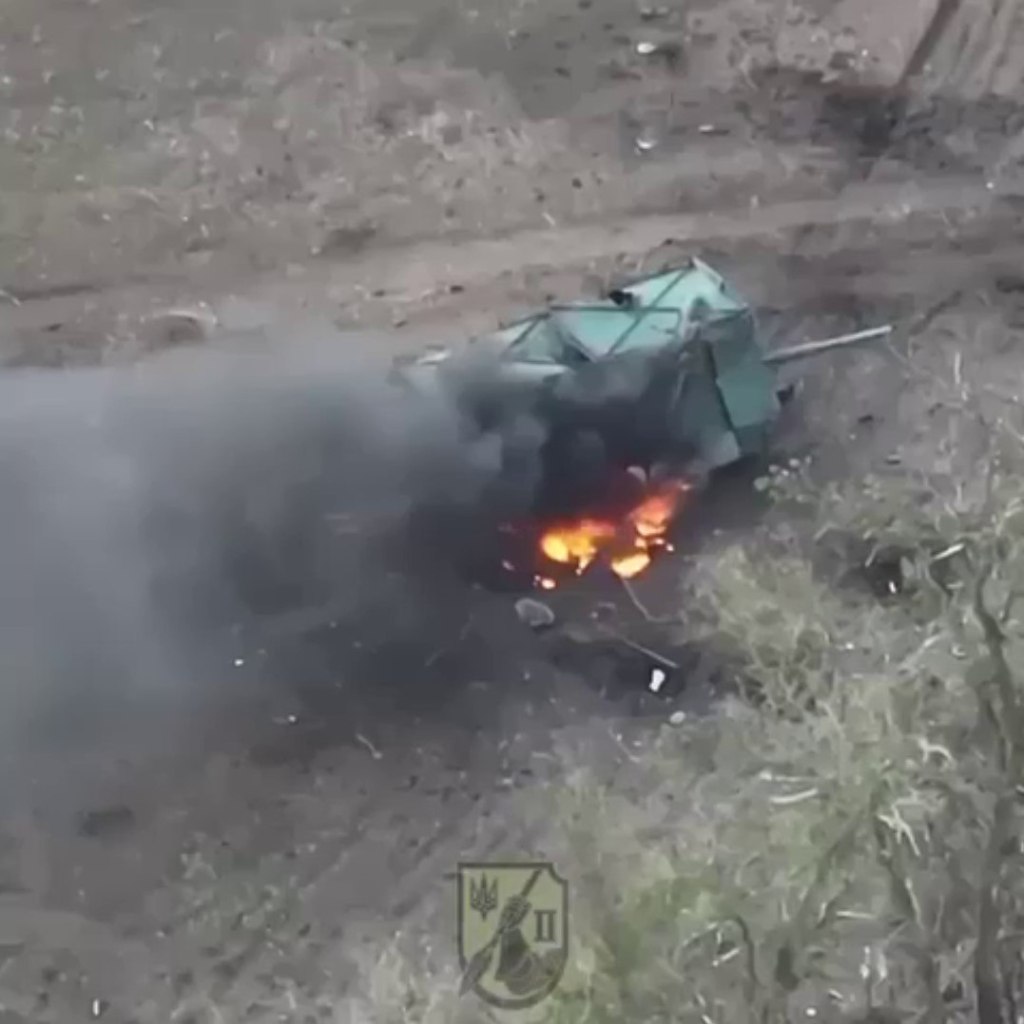
Also on the 21 May, the 2nd battalion of the 4th Rapid Reaction Brigade “Rubizh” destroyed a turtle tank in Makeevka, Lugansk. The video shows the tank with heavy damage to its shell, with a fire on its right side. The very brief clip shows what may be a Bonus or 155 SMART round detonating above the tank while its stationary, alternatively it may be a close range engagement of the tank with an infantry anti-tank weapon.
Update – 23/05/24:
A video of an abandoned T-62BV enclosed in a hybrid ‘shell’ made from mesh being struck by FPVs was shared on the 23 May. Additionally, a telegram channel shared what was claimed to be a conversation between Russian combatants discussing the possibility of using rubber matting on ‘turtle tanks’. This post included a photograph of a very rustic looking ‘turtle tank’ which featured a mix of metal sheeting and fence wire enclosing the rear opening.

Also on the 23 May further footage of a ‘Turtle Tank’, first seen on 6 May, was shared showing the tank burnt out and completely destroyed after it was previously seen immobilised.
Update – 28/5/24:
On the 27 May, Ukraine’s 71st Jaeger Brigade shared further drone footage of a classic Turtle Tank with a low profile, well built counter-FPV shell. The Ukrainian Armed Forces press centre first shared video of this engagement on the 25 May, dating the footage to at least before the 25 May. The post did not state the location of the engagement, just that it was successfully engaged by FPVs. Two of which entered the rear of the shell and detonated near the turret ring. The tank appears to be equipped with mine rollers, fitting the Turtle Tanks’ conventional role as breachers.
Footage published in late May, with date and location unconfirmed, shows a BMP-2 fitted with a counter FPV shell being damaged by a munition being dropped by a drone. The vehicle already seems to have been mobility killed.
An interesting hybrid-Turtle was seen in footage shared by the Apachi FPV Strike Group on 27 May. It shows a tank with what appears to be a net over a frame work protecting the turret and two layers of spaced armour on its sides (see images below).
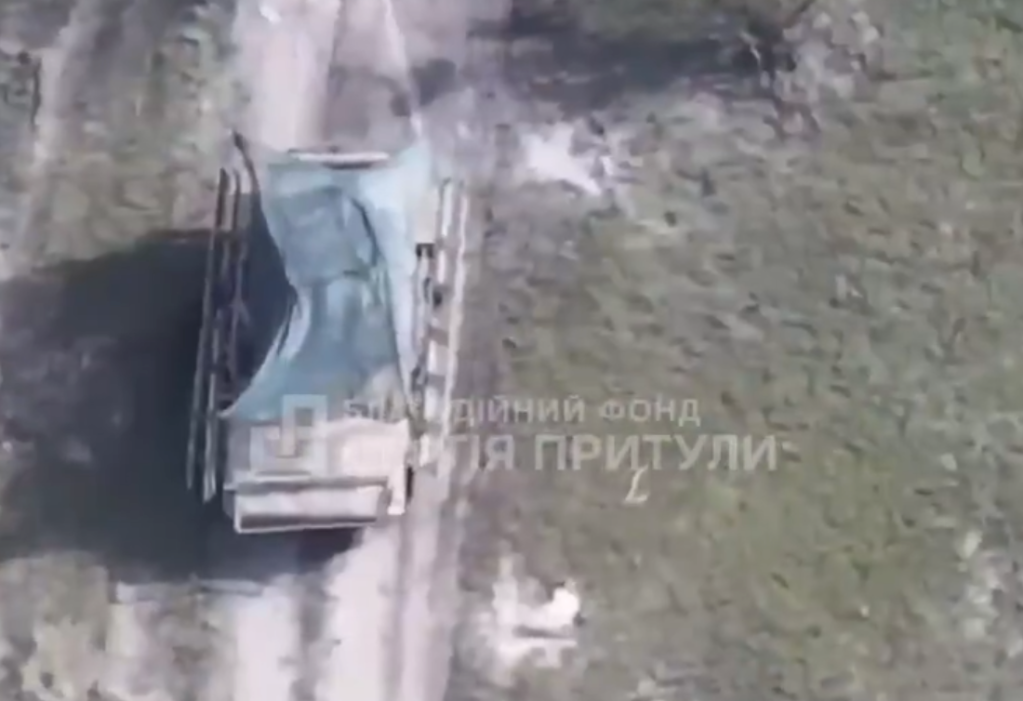
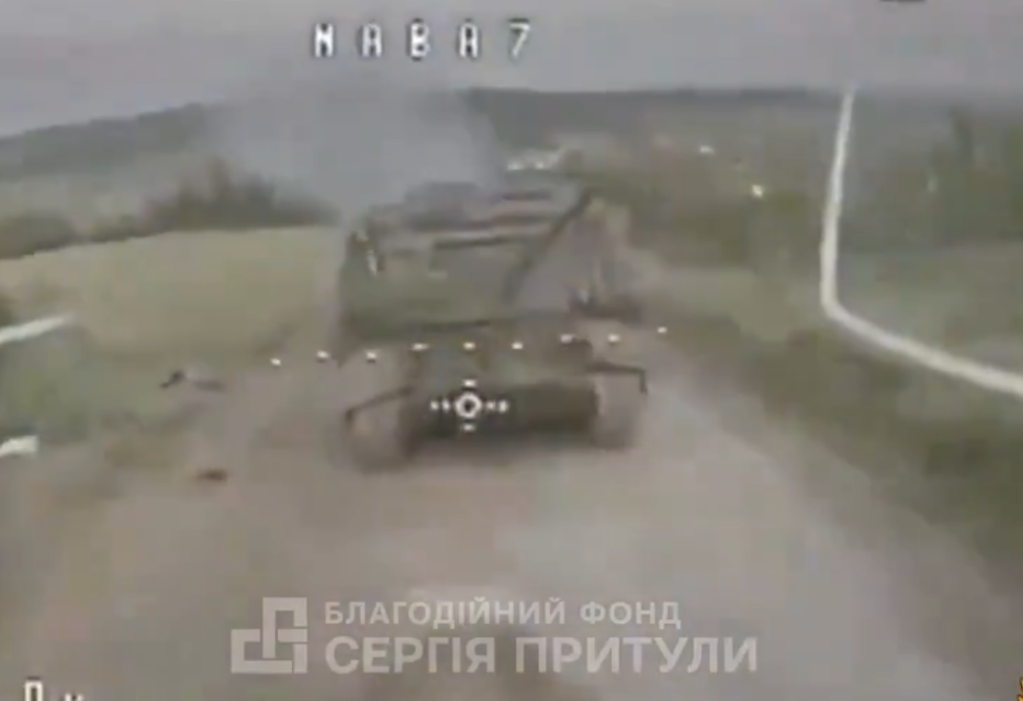
Also on 27 May, a single photograph of a T-72 being equipped with cage turret protection and horizontal slat protection on its sides was shared. It’s unclear what the vehicles finished form will by but other similar configurations have been covered with camouflage netting to make targetting more difficult for FPVs [Example].
On 28 May, Russia’s Zvezda News published a short video of Russian repair crews welding a set of mine ploughs on a Turtle Tank (or as the report calls them Tsar-Mangal / Tsar’s barbecue). The report notes that the T-72 featured was damaged so its turret was removed and a counter-FPV shell added to create a APC capable of carrying troops. In the footage a second Turtle Tank can be seen in the background. The report did not state the units location.

On the evening of the 28 May, footage of a road traffic accident near Korocha, in the Belgorod region, showed several vehicles involved in a crash including a Russian tank transporter carrying a Turtle Tank (see above). The KamAZ tank transporter can be seen jackknifed and on fire. The tank can be seen fitted with mine ploughs and a trapezoidal counter-FPV shell, with a open front and an enclosed rear.
Support Us: If you enjoyed this video and article please consider supporting our work here. We have some great perks available for Patreon Supporters – including early access to custom stickers and early access to videos! Thank you for your support!





